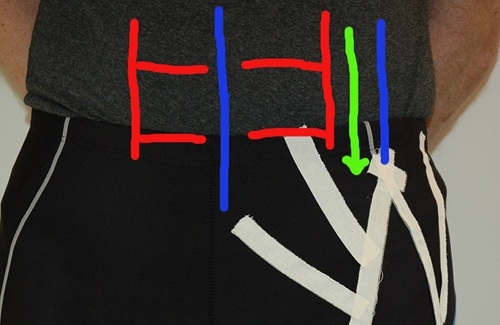Hip Flexors
As you may recall from our intro post on kinesiology taping, we’re going to focus on each muscle group/joint and show you how to use kinesiology tape in three distinct ways:
- Immediately after injury (for swelling and pain)
- During the healing process (correction techniques to restore normal position and allow for healing)
- Techniques to help improve strength + function
In this post, we’ re going to be talking about a taping application designed to decrease the amount of pull along the front of the hip where the hip flexors are located. This is perfect following an inner thigh/groin strain to provide support and allow for rest so that the injured muscle/tendon can heal.
Anatomy
The front of the hip is a busy intersection area (as you can see from the picture above). What we want to focus on is the Psoas/Illiacus muscles (aka the large hip flexor muscles). They insert into the front of the femur and then move up into the abdominal cavity to insert along the front of the lumbar spine. The Illiacus muscle inserts into the inside of the pelvic bone and the psoas move up to insert into the lumbar spine. To find their distal insertion onto the femur, you will need to work your way down the groin line.
In the picture above, the blue lines represent your two landmarks. The one at midline is your belly button and the other is your ASIS. The red lines represent your abdominal muscles. To find the distal portion of the psoas and illiacus, start on the blue lines and work your fingers in until you find the outer edge of your abs. Move just outside of them (towards the hip) and follow that down to the groin line (this is the green line in the picture). You can confirm that you are on the right area by lifting your knee up towards the ceiling and bending your hip. You should feel the muscles move beneath your finger tips.
You can read more about the anatomy and surrounding muscles in this area here.
What you will need:
1) Roll of kinesiology tape.
2) Sharpest scissors in the house.
Prep work:
1) Clean skin. This means no oils or lotions of any kind. You want your skin to be clean and more importantly dry. Moisture of any kind = tape will fall off or fail to stick altogether.
2) Hair care. Ideally, the less hair the better. Guys, this means that for best results you will need to trim any long leg hair or shave the calf area.
3) If clean, dry, and hairless skin still = no sticking of tape. Time to get some adhesive spray like Tuf Skin.
4) The tape should last 3-5 days. You can get it wet and shower with it on. Just towel dry it after. No hair dryer! The tape is heat activated.
Taping Techniques
1) Standard hip flexor taping application with optional correction strip.
Key Points:
- Do your homework first. Make sure you can find/palpate the hip flexor using the advice above.

- Prep the skin first. For this application you will want to put the hip flexor muscles on stretch. To do this, use a lunge position with the leg you will be taping in the back (knee on the ground) and the other leg in front. Lean into the front leg (which will extend the back hip). Only move as far as you can comfortably. If this is too much, you can also move the hip by laying on your back with your leg hanging off the side of a bed, couch or table. Let the leg relax and drop down towards the floor.
- The primary strip will be anchored next to the belly button. From here, position your leg to put the muscle on stretch and then apply the tape. The tape works by pulling on itself and you have already put the muscle on stretch to do the work for you. If you are unable to move the muscle into this position, you may add a small amount of stretch to the tape.
- A secondary correction strip can be applied to any specific sore spots. Cut the tape so that it is long enough to cover the painful area with 1-2″ of tape on either side (these are your anchors and must be applied without stretch). Round the edges, apply 50-75% stretch and place the tape. Then remove the paper backing and lay down the ends. Don’t sweat the 50-75%. Think medium stretch versus maximum “how far can I pull this tape” kind of stretch.
- In the case of pain in the front of the hip radiating down into the groin, you can combine this application with the adductor taping application. Click here to review.
- See the video above for full details.
- For further instructions on how to incorporate kinesiology taping into your self treatment regimen click here.
References
1) Capobianco, Dr. Steven and van den Dries, Greg. (2009). Power Taping, 2nd Edition, Rock Tape Inc, Los Gatos, CA.
2) Hammer, Warren. (2007). Functional Soft-Tissue Examination and Treatment by Manual Methods, 3rd edition. Jones and Bartlett Publishers, Inc, Sudbury, MA.
3) Kase, Kenzo, Wallis, Jim, and Kase, Tsuyoshi. (2003). Clinical Therapeutic Applications of the Kinesio Taping Method.
4) Muscolino, Joseph. (2009). The Muscle and Bone Palpation Manual. Mosby, Inc, St. Louis, MO.












